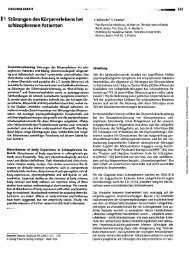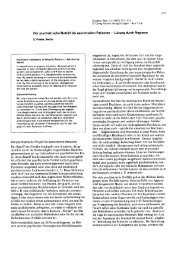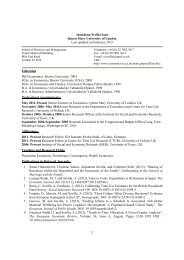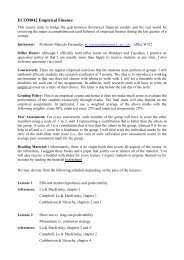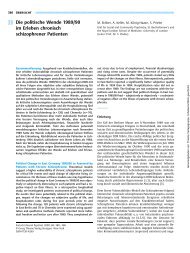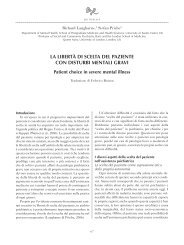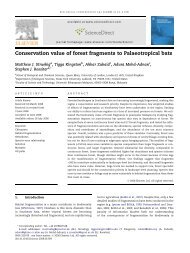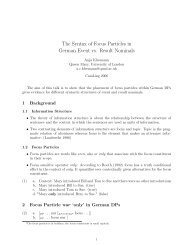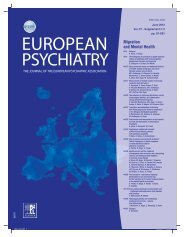burnout syndrome among physicians - Personal Webspace for ...
burnout syndrome among physicians - Personal Webspace for ...
burnout syndrome among physicians - Personal Webspace for ...
Create successful ePaper yourself
Turn your PDF publications into a flip-book with our unique Google optimized e-Paper software.
Psychiatria Danubina, 2011; Vol. 23, No. 4, pp 383-389 Original paper<br />
© Medicinska naklada - Zagreb, Croatia<br />
BURNOUT SYNDROME AMONG PHYSICIANS – THE ROLE OF<br />
PERSONALITY DIMENSIONS AND COPING STRATEGIES<br />
Bojana Pejušković 1 , Dušica Lečić-Toševski 1, 2 , Stefan Priebe 3 & Oliver Tošković 4<br />
1 Institute of Mental Health, Belgrade, Serbia<br />
2 Belgrade University, School of Medicine, Belgrade, Serbia<br />
3 Unit <strong>for</strong> Social and Community Psychiatry, Barts and the London School of Medicine, Queen Mary,<br />
University of London, London, UK<br />
4 Belgrade University School of Philosophy, Belgrade, Serbia, Serbia<br />
received: 15.2.2011; revised: 31.8.2011; accepted: 7.10.2011<br />
SUMMARY<br />
Background: Burnout <strong>syndrome</strong> (BS) and stress-related disorders are frequent <strong>among</strong> medical specialists, but it has been<br />
suggested that some health workers are more prone to the BS than others. This study assessed the intensity of the BS <strong>among</strong> 3 groups<br />
of <strong>physicians</strong>: psychiatrists, general practitioners and surgeons and examined correlation both between the intensity of BS and<br />
<strong>physicians</strong>` personality dimensions as well as between the level of BS and stress coping strategies.<br />
Subjects and methods: The sample consisted of 160 <strong>physicians</strong> (70 general practitioners, 50 psychiatrists, 40 surgeons). The<br />
assessment was carried out by the Maslach Burnout Inventory, The Temperament and Character Inventory and Manual <strong>for</strong> the Ways<br />
of Coping Questionnaire.<br />
Results: Dimension of emotional exhaustion was the most prominent in general practitioners (F=5.546, df1=2, df2=156,<br />
p
384<br />
Bojana Pejušković, Dušica Lečić-Toševski, Stefan Priebe & Oliver Tošković: BURNOUT SYNDROME AMONG PHYSICIANS – THE ROLE<br />
OF PERSONALITY DIMENSIONS AND COPING STRATEGIES Psychiatria Danubina, 2011; Vol. 23, No. 4, pp 383-389<br />
hard individuals are less prone to physical illness, more<br />
willing to accept social support, more optimistic, less<br />
stressed, capable of using a wider variety of coping<br />
strategies, and are less burned out (Rowe 2006). In<br />
cross-sectional studies, emotion-focused coping has<br />
been associated with job stress and BS <strong>among</strong><br />
<strong>physicians</strong> (Sharma et al. 2008, Deary et al. 1996). One<br />
recent longitudinal study has shown that reduction in<br />
emotion-focused coping and job stress preceded reducetion<br />
in emotional exhaustion (Isaksson Ro et al. 2010).<br />
The question repeatedly asked is why, under the<br />
same working conditions, one individual burns out,<br />
whereas another shows no symptoms at all. It seems fair<br />
to assume that other causes such as personality<br />
dimensions and the way of perceiving stress play<br />
important roles (Buhler & Land 2003, Morais et al.<br />
2006). The specific strategies may ultimately account<br />
<strong>for</strong> why one individual when exposed to an identical<br />
stressor becomes ill and another does not (Savicki<br />
2002).<br />
It seems that the BS in <strong>physicians</strong> does not differ<br />
from that <strong>syndrome</strong> in other professions, but <strong>physicians</strong>’<br />
reactions may be unique in some aspects, in part<br />
because they can have devastating consequences <strong>for</strong><br />
patients (Bruce et al. 2005, Gundersen 2001, Galeazzi et<br />
al. 2004). Also, the consequences of this <strong>syndrome</strong> can<br />
be manifold and could jeopardize a person on a<br />
psychological and somatic level (Ahola et al. 2006,<br />
Akerstedt et al. 2007, Armon et al. 2008), as well as<br />
affect the capability <strong>for</strong> work (Chiu & Tsai 2006).<br />
The highest BS indices were found in surgery<br />
(Sharma et al 2008), general practice (Cathebras et al.<br />
2004, Goehring et al. 2005), psychiatry (Priebe et al.<br />
2005, Fischer et al. 2007), child psychiatry, internal<br />
medicine, intensive care and oncology (Embriaco et al.<br />
2007, Asai et al. 2007, Travado et al. 2005). Some<br />
authors suggest that psychiatrists as a group are<br />
vulnerable to experiencing BS, more than other<br />
<strong>physicians</strong> and surgeons (Kumar 2007).<br />
The objective of our study was to examine the intensity<br />
of BS <strong>among</strong> 3 groups of <strong>physicians</strong>: psychiatrists,<br />
general practitioners and surgeons and compare<br />
expressiveness of the dimensions of BS in these groups,<br />
but also to identify the role and effect of personality<br />
dimensions and coping strategies. Also, we established<br />
the relationship between BS and sociodemographic<br />
variables and role of gender.<br />
SUBJECTS AND METHODS<br />
This was a cross-sectional survey of 160 <strong>physicians</strong><br />
of different specialties: 70 general practitioners (43.8%)<br />
working in public health centres, 50 psychiatrists<br />
(31.3%) and 40 general surgeons (25%) employed at<br />
Belgrade university clinics. The data were collected<br />
during 2007. There were 57 male (35.6%) and 103<br />
female (64.4%) <strong>physicians</strong>. In the male group 5 <strong>physicians</strong><br />
were general practitioners (3.1%), 17 were<br />
psychiatrists (10.6%) and 35 were surgeons (21.9%). In<br />
the female group 65 of them were general practitioners<br />
(40.6%), 33 were psychiatrists (20.6%) and five were<br />
surgeons (3.1%). The mean age of the subjects was 45<br />
years (SD 8.14), ranging from 30 to 64 years. As <strong>for</strong><br />
their marital status, 122 were married (76.3%), 23<br />
<strong>physicians</strong> were single (14.4%), 12 were divorced<br />
(7.5%), and 3 (1.9%) were widows/widowers.<br />
The in<strong>for</strong>med consent was obtained and the acquired<br />
data were kept confidential. The Ethical Committee of<br />
the Institute of Mental Health approved the study. The<br />
instruments have been administrated face to face but<br />
<strong>physicians</strong> filled up the questionnaires anonymously and<br />
put them into boxes which were prepared <strong>for</strong> that<br />
purpose in each institution. Participants have taken<br />
about 45 minutes to complete the survey. We have<br />
administered equal number of questionnaires to each<br />
group (70), but the response rate was 100% in general<br />
practitioners, in psychiatrists it was 71.43%, and in<br />
surgeons 57.14%.<br />
Measures<br />
A structured questionnaire covered the sociodemographic<br />
characteristics (age, gender, marital state, type<br />
of education, occupation, years in present position,<br />
years in the profession) and job details (caseloads,<br />
length of experience, professional responsibilities, and<br />
activities per week, daily number of patient).<br />
Burnout<br />
The BS was assessed using the Maslach Burnout<br />
Inventory (MBI) (Maslach et al. 1996), which is a selfreport<br />
tool with 22 items yielding scores <strong>for</strong> three<br />
components - emotional exhaustion (EE), depersonalization<br />
(DP) and reduced personal accomplishment (PA).<br />
The participants were asked to provide a rating <strong>for</strong> each<br />
item, ranging from (0) – never, to (6) - everyday (with<br />
possible sum scores of <strong>burnout</strong> ranging from 0 to 132).<br />
<strong>Personal</strong>ity dimensions<br />
The personality assessment was carried out by the<br />
Temperament and Character Inventory (TCI) (Cloninger<br />
et al. 1994). It is a 240-items questionnaire which<br />
evaluates 7 dimensions of personality including 4 temperament<br />
and 3 character dimensions, such as Novelty<br />
Seeking, Harm Avoidance, Reward Dependence, Persistence,<br />
Self-Directedness, Cooperativeness, and Self-<br />
Transcendence. The temperament traits are automatic<br />
responses to emotional stimuli that are evident in<br />
infancy and remain constant throughout life. The<br />
character traits mature through social learning and<br />
develop from infancy through adulthood in a stepwise<br />
fashion. Each question is rated on a Likert-type 5-point<br />
scale.<br />
Coping strategies<br />
The coping strategies were assessed by the revised<br />
version of the Ways of Coping Questionnaire (Lazarus<br />
& Folkman 1988) with 39 items and 8 subscales (Social
Bojana Pejušković, Dušica Lečić-Toševski, Stefan Priebe & Oliver Tošković: BURNOUT SYNDROME AMONG PHYSICIANS – THE ROLE<br />
OF PERSONALITY DIMENSIONS AND COPING STRATEGIES Psychiatria Danubina, 2011; Vol. 23, No. 4, pp 383-389<br />
Support, Confrontative Coping, Distancing, Selfcontrol,<br />
Positive Reappraisal, Planned Problem-solving,<br />
Escape-avoidance and Accepting responsibility. All<br />
subscales have 5 items with the exception of the last one<br />
which has 4 items. The subjects were asked to indicate<br />
how they coped with difficulties in the stressful<br />
situations. Each question is rated on a Likert-type 3point<br />
scale.<br />
Statistical analysis<br />
The data were analyzed using the Statistical Package<br />
<strong>for</strong> Social Science (SPSS Version 11). One-way<br />
analysis of variance (ANOVA) with Scheffe post-hoc<br />
test was used to test the statistical significance of<br />
differences between three groups of doctors on BS. The<br />
same analysis tested the correlation between marital<br />
status and BS. T-test <strong>for</strong> independent samples was used<br />
to test the differences between the two genders in<br />
intensity of BS and Pearson correlation to assess<br />
associations between age, years of practice, daily<br />
number of patients and intensity of BS. In order to test<br />
associations between BS and personality dimensions, as<br />
well as between BS and coping strategies we used<br />
canonical correlation analysis. In all per<strong>for</strong>med analysis,<br />
a significance criterion equal to, or smaller than 0.05,<br />
was used to determine statistical significance.<br />
RESULTS<br />
The score of the BS was moderate in all three<br />
examined groups. The emotional exhaustion <strong>for</strong> the<br />
whole sample was 22.57 (range is between 0 and 27 or<br />
over), depersonalization was 5.01 (range is between 0<br />
and 13 or over) and personal accomplishment was 37.27<br />
(range is between 0 and 39 or over, scored in opposite<br />
direction). One-way analysis of variance (ANOVA) has<br />
shown a significant difference in intensity of the BS<br />
between the 3 examined groups of <strong>physicians</strong>. Statistically<br />
significant difference between the groups was<br />
shown in all dimensions of BS - emotional exhaustion<br />
(F2.156=5.546, p
386<br />
Bojana Pejušković, Dušica Lečić-Toševski, Stefan Priebe & Oliver Tošković: BURNOUT SYNDROME AMONG PHYSICIANS – THE ROLE<br />
OF PERSONALITY DIMENSIONS AND COPING STRATEGIES Psychiatria Danubina, 2011; Vol. 23, No. 4, pp 383-389<br />
According to the structure of the first canonical<br />
function, the BS and personality dimensions could be<br />
correlated in the following way: lack of personal<br />
accomplishment was in negative correlation with the<br />
Harm Avoidance and in positive correlation with<br />
Reward Dependence, Persistence, Self-Directedness and<br />
Cooperativeness. Depersonalization was in negative<br />
correlation with Reward Dependence, Persistence, Self-<br />
Directedness and Cooperativeness and in positive<br />
correlation with Harm Avoidance. In this case canonical<br />
correlation was relatively high (Rho=0.661), meaning<br />
that in our sample personality dimensions and BS share<br />
44% of variance.<br />
According to the second canonical function, the<br />
Emotional Exhaustion was positively correlated with the<br />
Harm Avoidance (Table 1, Figure 3). Canonical correlation<br />
was moderate (Rho=0.442), meaning that, in this<br />
relation, personality dimensions and BS share 19.5% of<br />
variance.<br />
The third canonical function has shown that<br />
Depersonalization was in positive correlation with<br />
Persistence and Self-Transcendence and in negative<br />
correlation with Harm Avoidance (Table 1, Figure 3).<br />
For this function, canonical correlation is also moderate<br />
(Rho=0.349), meaning that, personality dimensions and<br />
BS share 12.2% of variance.<br />
Table 1. Structure of canonical functions <strong>for</strong> <strong>burnout</strong> <strong>syndrome</strong> and personality dimensions<br />
Canonical function 1 Canonical function 2 Canonical function 3<br />
Burnout<br />
dimensions<br />
<strong>Personal</strong>ity<br />
dimensions<br />
Emotional exhaustion 0.239 -0.916* 0.321<br />
Depersonalization 0.673* 0.067 0.737*<br />
<strong>Personal</strong> accomplishment -0.968* -0.081 0.238<br />
Canonical function 1 Canonical function 2 Canonical function 3<br />
Novelty seeking 0.296 0.205 0.156<br />
Harm avoidance 0.598* -0.488* -0.401*<br />
Reward dependence -0.440* -0.382 -0.042<br />
Persistence -0.594* -0.235 0.599*<br />
Self-directedness -0.733* 0.380 -0.359<br />
Cooperativeness -0.901* -0.229 -0.216<br />
Self-transcendence<br />
* - significant correlation coefficients<br />
-0.058 0.019 0.714*<br />
By canonical correlation analysis we found that<br />
there was a correlation between the level of BS and<br />
stress coping strategies, since the analysis extracted one<br />
significant canonical function (Rho=0.343, Chi 2 =20.865,<br />
Table 2. Structure of canonical functions <strong>for</strong> <strong>burnout</strong><br />
<strong>syndrome</strong> and coping strategies<br />
Canonical<br />
function<br />
Burnout<br />
dimensions<br />
Emotional exhaustion<br />
Depersonalization<br />
<strong>Personal</strong> accomplishment<br />
0.239<br />
0.008*<br />
-0.599*<br />
Canonical<br />
function<br />
Confrontative coping 0.198<br />
Distancing -0.149<br />
Coping<br />
strategies<br />
Self-control 0.354*<br />
Social support 0.154<br />
Accepting responsibility. 0.058<br />
Escape/Avoidance -0.770*<br />
Planned problem-solving 0.264<br />
Positive reappraisal 0.128<br />
* - significant correlation coefficients<br />
df=6 p
Bojana Pejušković, Dušica Lečić-Toševski, Stefan Priebe & Oliver Tošković: BURNOUT SYNDROME AMONG PHYSICIANS – THE ROLE<br />
OF PERSONALITY DIMENSIONS AND COPING STRATEGIES Psychiatria Danubina, 2011; Vol. 23, No. 4, pp 383-389<br />
Figure 4 Structure of canonical function <strong>for</strong> coping<br />
strategies and <strong>burnout</strong> dimensions<br />
DISCUSSION<br />
Our findings have shown that surgeons had the<br />
highest and psychiatrists the lowest score of the total<br />
BS. Emotional exhaustion was the most prominent in<br />
general practitioners while depersonalization and lack of<br />
personal accomplishment in surgeons. These findings<br />
are in accordance with results obtained by Sharma with<br />
collaborators (Sharma et al. 2008) who have shown high<br />
level of depersonalization and low level of personal<br />
accomplishment in surgeons. They are also consistent<br />
with previous findings of studies of general <strong>physicians</strong><br />
which have shown high levels of emotional exhaustion<br />
(Arigoni et al. 2010, Goehring et al. 2005, Grassi &<br />
Magnani 2000).<br />
Our findings have also shown that <strong>physicians</strong> with<br />
greater daily number of patients were more prone to<br />
emotional exhaustion, which is in accordance with our<br />
previous study (Lecic-Tosevski et al. 2006), but that<br />
these <strong>physicians</strong> had higher sense of personal<br />
accomplishment. The older <strong>physicians</strong>, with greater<br />
years of practice and daily number of patients were less<br />
prone to depersonalization. Some studies have shown<br />
that the level of BS is decreasing with age and that<br />
younger surgeons were more likely to have a high level<br />
of depersonalization (Sharma et al. 2008, Ahola et al.<br />
2006). It seems that daily number of patient can be<br />
protective and harmful at the same time.<br />
The differences between genders were interesting -<br />
the emotional exhaustion was higher in women, the lack<br />
of personal accomplishment was higher in men while<br />
the dimension of depersonalization was the same in the<br />
both genders. In contrast to our findings, other authors<br />
have shown that women <strong>physicians</strong> had 1.6 times higher<br />
<strong>burnout</strong> compared to men (McMurray et al. 2001) and<br />
that men are more prone to depersonalization (Schaufeli<br />
& Greenglass 2001).<br />
Our findings have shown that personality dimensions<br />
might be important <strong>for</strong> development of the BS.<br />
We found that the most important dimension was the<br />
Harm Avoidance, which might be a »negative« dimension<br />
which leads to a development of the BS, particularly<br />
to low personal accomplishment, high depersona-<br />
lization and high emotional exhaustion. Cooperativeness<br />
and Self-Directedness might be potential protective<br />
dimensions. However, the development of BS probably<br />
depends on combination and interaction of personality<br />
dimensions, and not on some particular, independent<br />
dimension.<br />
Our findings are in accordance with the results of<br />
similar studies which have shown the important link<br />
between personality and BS (Maslach et al. 2001, Mitra<br />
et al. 2003, Kumar 2007, Buhler & Land 2003, Glasberg<br />
et al. 2007, Narumoto et al. 2008, Gustafsson et al.<br />
2009). According to our knowledge not many studies<br />
have used the TCI, particularly not in <strong>physicians</strong>’<br />
population. However, there are studies which have used<br />
other personality inventories and have shown the<br />
important link between BS and personality. Mitra and<br />
collaborators (Mitra et al. 2003) used the TCI but <strong>for</strong><br />
comparison of surgeons and anesthesiologists and did<br />
not find any significant differences. Oginska-Bulik<br />
(Oginska-Bulik 2006) has pointed out the role of Type<br />
D personality and negative affectivity in the development<br />
of BS. Buhler and Land (Buhler & Land 2003) by<br />
using Eysenck <strong>Personal</strong>ity Inventory have shown positive<br />
correlations of the “external locus of control” with<br />
the BS variables of emotional exhaustion and depersonalization.<br />
A recent study in dentistry has shown that<br />
narcissistic and borderline personalities are most<br />
frequently found in the individuals with the BS<br />
(Alemany et al. 2008). A study on health-care personnel<br />
in Sweden has shown that the most important indicators<br />
<strong>for</strong> “belonging to the <strong>burnout</strong>” were “openness to<br />
changes” and “anxiety”, and <strong>for</strong> “belonging to the non<strong>burnout</strong>”,<br />
“emotional stability”, “liveliness”, “privateness”<br />
(i.e. <strong>for</strong>thright or discreet) and “tension”<br />
(Gustafsson et al. 2009).<br />
Our findings have also shown that coping strategies<br />
might be very important <strong>for</strong> development of BS –<br />
Escape-avoidance might lead to depersonalization and<br />
lack of personal accomplishment, while self-control is a<br />
good way to cope with prolonged job stress and leads to<br />
a higher personal accomplishment and low depersonalization.<br />
This is in accordance with other studies<br />
which have shown the important role of emotionfocused<br />
stress coping strategies (Narumoto et al. 2008,<br />
Sharma et al. 2008, Isaksson Ro et al. 2010). One recent<br />
study of surgeons and nurses has shown that coping<br />
strategies, especially those in which respondents isolated<br />
themselves from friends and family, were associated<br />
with higher psychiatric morbidity and BS (Sharma et al.<br />
2008). Rowe (Rowe 2006) has shown that subjects who<br />
were taught to develop proactive strategies, such as<br />
direct problem solving were more effective in coping<br />
with stress, felt stronger sense of personal accomplishment,<br />
and were less emotionally exhausted.<br />
According to a recent study of Japanese professional<br />
caregivers, higher neuroticism and higher emotionoriented<br />
coping are associated with higher BS<br />
(Narumoto et al. 2008). The most authors suggest that<br />
social support is the best coping strategy against<br />
387
388<br />
Bojana Pejušković, Dušica Lečić-Toševski, Stefan Priebe & Oliver Tošković: BURNOUT SYNDROME AMONG PHYSICIANS – THE ROLE<br />
OF PERSONALITY DIMENSIONS AND COPING STRATEGIES Psychiatria Danubina, 2011; Vol. 23, No. 4, pp 383-389<br />
developing BS (Lindblom et al. 2006, Glasberg et al.<br />
2007, Bakker et al. 2004, Prins et al. 2007). The results<br />
of one recent longitudinal study indicated that it was<br />
reduction in emotion-focused coping strategies that<br />
influenced decrease in emotional exhaustion (Isaksson<br />
Ro et al. 2010). Since our findings have shown that<br />
coping strategies are not in significant correlation with<br />
emotional exhaustion it opens space <strong>for</strong> discussion and<br />
further research.<br />
The limitations of our study are the sample size<br />
since the number of subjects in each examined groups<br />
were not equal. Also, the cross-sectional research design<br />
provides no in<strong>for</strong>mation of the <strong>burnout</strong> process and does<br />
not allow affirmative causal explanation. There<strong>for</strong>e,<br />
further research needs to approach the process of BS in<br />
longitudinal studies.<br />
CONCLUSION<br />
Our findings could have practical implications on<br />
the BS and its development. There are a number of<br />
potential negative and protective factors <strong>for</strong> development<br />
of this <strong>syndrome</strong>. We believe that findings of<br />
important role of personality dimensions and coping<br />
strategies could be helpful in identifying individuals<br />
with a tendency towards development of BS and timely<br />
application of preventive strategies. The European<br />
Forum of Medical Associations and World Health<br />
Organization have issued in 2003 a statement of the BS<br />
<strong>among</strong> <strong>physicians</strong> (EFMA 2003). The statement expressed<br />
EFMA’s serious concern about the increase in BS<br />
levels, encouraging all national medical associations to<br />
increase awareness of the problem and recommended<br />
that the situation should be monitored. In practice, it<br />
would be important to establish preventive measures<br />
such as stress management and improvement of the<br />
stress coping strategies in order to avoid negative conesquences<br />
both at professional and the personal level.<br />
REFERENCES<br />
1. Ahola K, Honkonen T, Isometsa E, Kalimo R, Nykyri E,<br />
Aromaa A, Lonnqvist J. Burnout in the general<br />
population-Results from the Finnish Health 2000 Study.<br />
Soc Psychiatry Psychiatr Epidemiol. 2006; 41:11-17.<br />
2. Akerstedt T, Kecklund G, Gillberg M. Sleep and sleepiness<br />
in relation to stress and displaced work hours. Physiol<br />
Behav. 2007; 92: 250-55.<br />
3. Alemany MA, Berini AL, Gay EC. The <strong>burnout</strong> <strong>syndrome</strong><br />
and associated personality disturbances. The study in<br />
three graduate programs in Dentistry at the University of<br />
Barcelona. Med Oral Patol Oral Cir Bucal. 2008; 13:<br />
444-50.<br />
4. Arigoni F, Bovier PA, Sappino AP. Trend of <strong>burnout</strong><br />
<strong>among</strong> Swiss doctors. Swiss Med Wkly. 2010; 140: 13070.<br />
5. Armon G, Shirom A, Shapira I, Melamed S. On the nature<br />
of <strong>burnout</strong>-insomnia relationships: a prospective study of<br />
employed adults. J Psychosom Res. 2008; 65: 5-12.<br />
6. Asai M, Morita T, Akechi T, Sugawara Y, Fujimori M,<br />
Akizuki N, Nakano T, Uchitomi Y. Burnout and psychiatric<br />
morbidity <strong>among</strong> <strong>physicians</strong> engaged in end-of-life care<br />
<strong>for</strong> cancer patients: A cross-sectional nationwide survey<br />
in Japan. Psycho-Oncol. 2007; 16:421-28.<br />
7. Bakker AB, Demerouti E, Verbeke W. Using the job<br />
demands-resources model to predict <strong>burnout</strong> and<br />
per<strong>for</strong>mance. HRM. 2004; 43: 83-104.<br />
8. Bruce SM, Conaglen HM, Conaglen JV. Burnout in<br />
<strong>physicians</strong>: a case <strong>for</strong> peer-support. Int Med J. 2005; 35:<br />
272-78.<br />
9. Buhler KE, Land T. Burnout and personality in intensive<br />
care: An empirical study. Hosp Top. 2003; 8: 5-12.<br />
10. Burke RJ, Greenglass ER. Hospital restructuring and<br />
nursing staff well-being: The role of perceived hospital<br />
and union support. Anxiety, Stress Coping. 2001; 14: 93-<br />
115.<br />
11. Cathebras P, Begon A, Laporte S, Bois C, Truchot D.<br />
Burnout <strong>among</strong> French general practitioners. Presse Med.<br />
2004; 18:1569-74.<br />
12. Chiu SF, Tsai MC. Relationships <strong>among</strong> <strong>burnout</strong>, job<br />
involvement, and organizational citizenship behavior. J<br />
Psychol. 2006; 14: 517- 30.<br />
13. Cloninger RC, Przybeck TR, Svrakic DM, Wetzel RD. The<br />
Temperament and Character inventory (TCI): A Guide to<br />
its Development and Use. St. Louis. 1994.<br />
14. Deary IJ, Blenkin H, Agius RM, Endler NS, Zealley H,<br />
Wood R. Models of job-related stress and personal<br />
achievement <strong>among</strong> consultant doctors. Br J Psychol.<br />
1996; 87:3-29.<br />
15. De Jonge J, Dormann C. The DISC Model: demandinduced<br />
strain compensation mechanism in job stress. In<br />
M.F. Dollard, A.H. Winefield & H.R. Winefield (Eds.),<br />
Occupational stress in the service professions (pp. 75-<br />
101). London, New York: Taylor & Francis. 2003.<br />
16. Ekstedt M, Fagerberg I. Lived experiences of the time<br />
preceding <strong>burnout</strong>. J Adv Nurs. 2005; 49: 59-67.<br />
17. Embracio N, Papazian L, Kenetish-Barnes N, Pochard F,<br />
Azoulay E. Burnout <strong>syndrome</strong> <strong>among</strong> critical care<br />
healthcare workers. Curr Opin Crit Care. 2007; 13: 482-<br />
88.<br />
18. European Forum of Medical Associations and World<br />
Health Organization (2003, February). Statement of the<br />
<strong>burnout</strong>-<strong>syndrome</strong> <strong>among</strong> <strong>physicians</strong>. EFMA, Berlin.<br />
19. Fischer J, Kumar S, Hatcher S. What makes psychiatry<br />
such a stressful profession? Australas Psychiatry 2007;<br />
5:417-21.<br />
20. Galeazzi GM, Delmonte S, Fakhoury W, Priebe S. Morale<br />
of mental health professionals in community mental health<br />
services of a Northern Italian province. Epidemiol<br />
Psichiatr Soc. 2004; 13: 191-97.<br />
21. Glasberg AL, Eriksson S, Norberg A. Burnout and „stress<br />
of conscience“ <strong>among</strong> healthcare personnel. J Adv Nurs.<br />
2007: 13: 392-403.<br />
22. Goehring C, Gallacchi MB, Kunzi B, Bovier P.<br />
Psychosocial and professional characteristics of <strong>burnout</strong><br />
in Swiss primary care practitioners: a cross sectional<br />
survey. Swiss Med Wkly 2005; 135:101-8.<br />
23. Grassi L, Magnani K. Psychiatric morbidity and <strong>burnout</strong><br />
in the medical profession: an Italian study of general<br />
practitioners and hospital <strong>physicians</strong>. Psychother<br />
Psychosom. 2000; 69:329-34.<br />
24. Gundersen L. Physician <strong>burnout</strong>. Ann Int Med. 2001; 4:<br />
145-48.<br />
25. Gustafsson G, Persson B, Eriksson S, Norberg A,<br />
Strandberg G. <strong>Personal</strong>ity traits <strong>among</strong> burnt out and
Bojana Pejušković, Dušica Lečić-Toševski, Stefan Priebe & Oliver Tošković: BURNOUT SYNDROME AMONG PHYSICIANS – THE ROLE<br />
OF PERSONALITY DIMENSIONS AND COPING STRATEGIES Psychiatria Danubina, 2011; Vol. 23, No. 4, pp 383-389<br />
non-burnt out health-care personnel at the same<br />
workplaces: a pilot study. Int J Ment Health Nurs. 2009;<br />
18: 336-48.<br />
26. Isaksson Ro KE, Tyssen R, Hoffart A, Sexton H, Aasland<br />
OG, Gude T. A three-year cohort study of the relationships<br />
between coping, job stress and <strong>burnout</strong> after a<br />
counselling intervention <strong>for</strong> help-seeking <strong>physicians</strong>. BMC<br />
Pub Health. 2010; 10:213.<br />
27. Katschnig H. Are psychiatrists an endangered species?<br />
Observations on internal and external challenges to the<br />
profession. World Psychiatry. 2010; 9: 21-8.<br />
28. Koeske GF, Kirk SA, Koeske RD. Coping with job stress:<br />
Which strategies work best? Journal of Occupational and<br />
Organizational Psychology . 1993; 66: 319-35.<br />
29. Kumar, S. Burnout in psychiatrists. World Psychiatry.<br />
2007; 6:186-89.<br />
30. Kumar S, Bhagat RN, Lau T, Ng B. Psychiatrists in New<br />
Zealand: are they burning out, satisfied at work and, in<br />
any case, who cares? Australas Psychiatry. 2006; 14:20-3.<br />
31. Kushnir T, Cohen AH. Job structure and <strong>burnout</strong> <strong>among</strong><br />
primary care pediatricians. Work. 2006; 27: 67-74.<br />
32. Lazarus, R.S., & Folkman, S. Manual <strong>for</strong> the Ways of<br />
Coping Questionnaire. Palo Alto, Cali<strong>for</strong>nia: Consulting<br />
Psychologists Press, 1988.<br />
33. Lecic-Tosevski D, Pejovic-Milovancevic M, Pejuskovic B,<br />
Deusic-Popovic S, Hoftvedt BO, Tanovic-Mikulec E.<br />
Burnout <strong>syndrome</strong> of general practitioners in postwar<br />
period. Epidemiol Psichiatr Soc. 2006; 4: 307-10.<br />
34. Lesic AR, Stefanovic NP, Perunicic I, Milenkovic P,<br />
Tosevski DL, Bumbasirevic MZ. Burnout in Belgrade<br />
orthopedic surgeons and general practitioners, a<br />
preliminary report. Acta Chir Iugosl. 2009; 56: 53-9.<br />
35. Lindblom KM, Linton SJ, Fedeli C, Bryngelsson IL. Burnout<br />
in the working population: Relations to psychosocial<br />
work factors. Int J Behav Med. 2006; 9: 51-9.<br />
36. Maslach C, Jackson SC, Leiter MP. Maslach Burnout<br />
Inventory. Palo Alto, Cali<strong>for</strong>nia: Consulting Psychologists<br />
Press, 1996.<br />
37. Maslach C, Schaufeli WB, Leiter MP. Job <strong>burnout</strong>. Annu<br />
Rev Psychol. 2001; 52: 397-422.<br />
38. McMurray JE, Linzer M, Konrad TR, Douglas J,<br />
Shugerman R, Nelson K. The work lives of women<br />
<strong>physicians</strong>. J Gen Int Med. 2001; 15:372-80.<br />
39. Mitra S, Sinha PK, Gombar KK, Basu D. Comparison of<br />
temperament and character profiles of anesthesiologists<br />
and surgeons: a preliminary study. Indian J Med Sci.<br />
2003; 6: 431-36.<br />
40. Morais A, Maia P, Azevedo A, Amaral C, Tavers J. Stress<br />
and <strong>burnout</strong> <strong>among</strong> Portuguese anesthesiologists. Eur J<br />
Anaesthesiol. 2006; 23: 433-39.<br />
41. Narumoto J, Nakamura K, Kitabayashi Y, Shibata K,<br />
Nakamae T, Fukui K. Relationships <strong>among</strong> <strong>burnout</strong>,<br />
coping style and personality: Study of Japanese<br />
Correspondence:<br />
Bojana Pejušković, MD, MA<br />
Institute of Mental Health<br />
Palmoticeva 37, 11000 Belgrade, Serbia<br />
E-mail: bpejuskovic@eunet.rs<br />
professional caregivers <strong>for</strong> elderly. Psychiatry Clin<br />
Neurosci. 2008; 62: 174-76.<br />
42. Ngidi DP, Sibaya PT. Black teachers’ personality<br />
dimensions and work-related stress factors. S Afr J<br />
Psychol. 2002; 32: 7-16.<br />
43. Oginska-Bulik N. The role of personal and social<br />
resources in preventing adverse health outcomes in<br />
employees of uni<strong>for</strong>med professions. Int J Occup Med<br />
Environ Health. 2005; 18: 233-40.<br />
44. Oginska-Bulik, N. Occupational stress and its<br />
consequences in healthcare professionals: the role of type<br />
D personality. Int J Occup Med Environ Health. 2006; 10:<br />
113-22.<br />
45. Pejuskovic B, Lecic-Tosevski D. Burnout in psychiatrists,<br />
general practitioners and surgeons. World Psychiatry.<br />
2011; 10: 78.<br />
46. Priebe S, Fakhoury WKH, Hoffmann K, Powell T. Morale<br />
and job perception of community mental health<br />
professionals in Berlin and London. Soc Psychiatry<br />
Psychiatr Epidemiol. 2005; 46: 223-32.<br />
47. Prins JT, Hoekstra-Weebers JEHM, Gazedendam-<br />
Donofrio SM, Van de Wiel HBM, Sprangers F, Jaspers<br />
FCA, Van der Heijden, FMMA. The role of social support<br />
in <strong>burnout</strong> <strong>among</strong> Dutch medical residents. Psychol<br />
Health Med. 2007; 12: 1-6.<br />
48. Rowe MM. Four-year longitudinal study of behavioral<br />
changes in coping with stress. Am J Health Behavi. 2006;<br />
6: 602-12.<br />
49. Savicki V. Burnout across Thirteen Cultures: Stress, and<br />
Coping in Child and Youth Care Workers. Westport:<br />
Praeger, 2002.<br />
50. Schaufeli WB, Greenglass ER. Introduction to special<br />
issue on <strong>burnout</strong> and health. Psychol Health. 2001;<br />
16:501-10.<br />
51. Schwartz RW, Barclay JR, Harrell PL, Murphy AE,<br />
Jarecky RK, Donnelly MB. Defining the surgical personality:<br />
a preliminary study. Surgery. 1994; 115: 62-8.<br />
52. Sears SF, Urizar GG, Evans GD. Examining a stresscoping<br />
model of <strong>burnout</strong> and depression in extension<br />
agents. J Occup Health Psychol. 2000; 5: 56-62.<br />
53. Sharma A, Sharp DM, Walker LG, Monson JR. Stress and<br />
<strong>burnout</strong> in colorectal and vascular surgical consultants<br />
working in the UK National Health Service. Psychooncology.<br />
2008; 17:570-76.<br />
54. Sharma A, Sharp DM, Walker LG, Monson JRT. Stress<br />
and <strong>burnout</strong> <strong>among</strong> colorectal nurse specialists working<br />
in the National Health Service. Colorectal Dis. 2008; 10:<br />
397-406.<br />
55. Travado L, Grassi L, Gil F, Ventura C, Martins C.<br />
Physician-patient communication <strong>among</strong> Southern<br />
European cancer <strong>physicians</strong>: the influence of psychosocial<br />
orientation and <strong>burnout</strong>. Psycho-Oncol. 2005; 14:661-70.<br />
389




